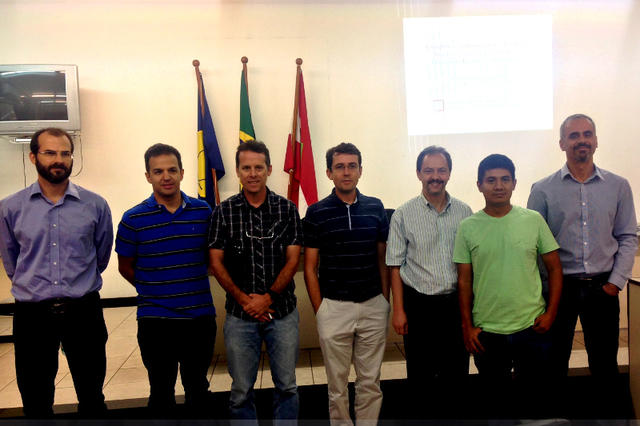Defesa de tese de doutorado: Fabian Cabrera
The Ph.D. candidate Fabian Cabrera defended his thesis: Wireless energy transfer optimization for miniaturized electronic implants.

The Ph.D. candidate Fabian Cabrera defended his thesis: Wireless energy transfer optimization for miniaturized electronic implants.

The paper “A 25-dBm 1-GHz Power Amplifier Integrated in CMOS 180nm
for Wireless Power Transferring“was awarded as the third best paper of the
28th Symposium on Integrated Circuits and Systems Design. (slides here)

 |
Thanks Dr. Brum
|
The Technical Chapter IEEE-IMS / CAS / COMMSOC (Florianópolis / South) invites you to the lecture Computational Intelligence for Motion Analysis: A Sensor Fusion Perspective by Dr. Carolina Brum Medeiros.
Download Lecture details. |
Thanks Prof. Postolache! |
|
 |
The Technical Chapter IEEE-IMS / CAS / COMMSOC (Florianópolis / South) invites you to the lecture Unobtrusive Smart Sensing and Pervasive Computing for Healthcare by Prof. Octavian Postolache, in the framework of the Distinguished Lecturer Program of the IEEE Instrumentation and Measurement Society.
Download Lecture details. |
 |
Professor Fernando Rangel presented the research activities conducted at UFSC Radiofrequency Lab for students and researchers of CEFET-MG. (slides here) |
 |
As diferentes tecnologias voltadas à instrumentação na área de petróleo e gás estão em ascensão. Aplicações baseadas em circuitos de RF e sensores eletromagnéticos são o foco desta proposta, que visa a elaboração de soluções práticas e de baixo custo para solucionar os diferentes problemas encontrados na indústria.O trabalho deverá ser realizado com o auxílio de uma ferramenta profissional de simulação eletromagnética e de CFD no Laboratório de Radiofrequência em parceria com o Laboratório Experimental de Escoamentos Multifásicos da UFSC.Para maiores informações: heron.eduardo.avila@gmail.com / rangel.fernando@gmail.com
|
The MSc. candidate Ronaldo Martins da Ponte successfully defended his thesis, in which he proposed an ultra-low power circuit integrated circuit to condition an ISFET sensor.
Renato Feitoza presented his Final Year Project on Metamaterial-Inspired Sensors entitled: “ Design of miniaturized antennas based on metamaterials for passive sensing applied to internet of things (IoT) “. (pdf)
Last Friday, Rodrigo Rottava presented his Final Year Project on Low Voltage/Low Power oscillators entitled: Analysis and Design of a Colpitts Oscillator with Double Positive Feedback Operating in High Frequency and LowVoltage/Low Power. (Slides here)
 |
The GRF/LRF work on WBAN was the subject of a talk by Prof. Rangel at NUTES (Núcleo de Tecnologias Estratégicas em Saúde).
On occasion, the GRF researcher presented an overview of WBAN research being conducted by the Research Group on Radio Frequency at UFSC, with emphasis on: a) the transmission of wireless power for miniaturized implants; b) Characterisation of the human body communication channel; c) integrated temperature sensor powered by RF; d) energy harvesting body temperature.
GRF believes that WBAN is the way for innovation in the next 25 years, however, to be successful the WBAN should consume low power and should operate without bulky batteries, so that they can be used or implanted, which are some of the challenges for circuit and system designers.
|
We are offering two opportunities for research assistants in undergraduate level (BOLSA DE INICIAÇÃO CIENTÍFICA). The selected candidates will do research on the following subjects:
Context: Ultra low power devices for Wireless Body Area Networks (WBAN). For medical applications the consumption
is the most critical design parameter, especially in implanted devices where it is inconvenient or impossible to replace the
battery. Therefore, we try to employ solutions such as: battery recharging via energy transfer or magnetic coupling, harvest of available energy in the environment.
PIBIC Requirements.
Some PIBIC Benefits
What to do?
You must send email with your resume (showing your skills, experience, and achievements) to schedule an appointment for the personal interview, before 22 july.
These interviews will be on 24 and 25 july (2014).
Contact :
Arturo Fajardo. arfaja1979@gmail.com
Paulo Marcio Moreira. p.marcio.moreira@gmail.com
Or, send us a message using the form found here.

Gustavo Campos defended his master thesis intitled: “RF-Powered CMOS Temperature Sensor“. His work presents the development of a wirelessly powered CMOS temperature sensor, designed to measure temperatures in the human body temperature range. The sensor receives energy through an RF signal emmited by a reader device. Once the sensor has enough energy, it sends data about the measured temperature to the reader. The system was designed to operate with signal levels as low as −10dBm centered at 900MHz. The sensor device is formed by the following circuits: rectifier, voltage limiter, reference source, operating mode selector, voltage regulator, oscillator and backscattering device. The system presented 8.5μA current comsumption in active mode and 4.9μA in standby mode. The developed sensor contains a calibration method, which was designed to achieve maximum temperature measurement error of 0.2 C.

Miniaturization is a primary concern today in communication
and biomedical systems. A highly miniaturized antenna
with electrical length 0.036λ x 0.044λ x 0.005λ
(11.25mm×13.80mm×1.55mm) was implemented based on
the zeroth-order resonance approach. The experimental resonance
frequency presented a slight shift to the right due to the
limited resolution of the fabrication process. The detailing of
the design methodology presented here can be a useful guide to
antenna designers who are working on miniaturized antennas.